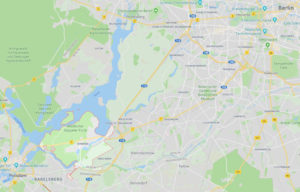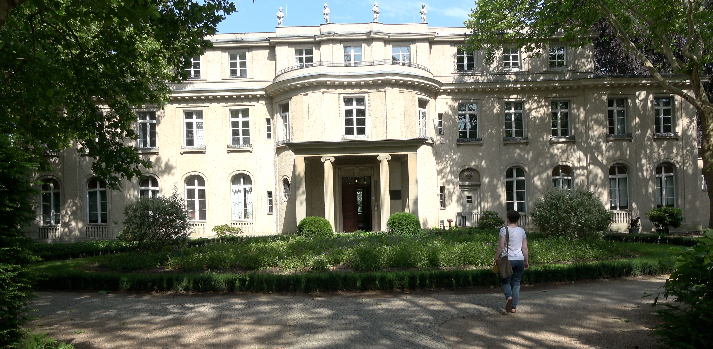 Wannsee is in the southwestern Berlin borough of Steglitz-Zehlendorf. Two lakes, the larger Großer Wannsee and the Kleiner Wannsee, are located on the River Havel. The area provides much scenic and recreational opportunities . . . and some history.
Wannsee is in the southwestern Berlin borough of Steglitz-Zehlendorf. Two lakes, the larger Großer Wannsee and the Kleiner Wannsee, are located on the River Havel. The area provides much scenic and recreational opportunities . . . and some history.
After visiting the former home of the Canaris family on June 14, the extended Canaris family invited Julia and me to join them on a boat tour of Wannsee. Prussian royalty of the late 18th century built “palaces” along the lakes, and on ‘Peacock Island.’ Those have been joined since by the homes or vacation homes of many of Germany’s notables. In this video (4:10), you’ll see homes and other buildings from a wide range of eras and in many different styles.
The ‘Wannsee House’
There is one particular villa of special note. It had been built in 1914-15 by a merchant and factory owner. The original owner sold it in 1923 to a firm owned by the industrialist Friedrich Minoux, an early ally of Adolf Hitler. Minoux sold the villa in 1940 to a foundation established by SS Obergrüppenfuhrer Reinhard Heydrich to build or acquire vacation resorts for the SS Security Service (SD).
On January 20, 1942, Heydrich and 14 other members of the SS hierarchy or senior government officials met at the villa to begin discussion of how to ensure that the elements of the German regime could bring about “the final solution of the Jewish question,” the systematic extermination of European Jews. The ‘Wannsee Conference’ lasted 90 minutes.
The building served as a school from 1952 until 1982, when it became a memorial. In 1992, on the 50th anniversary of the Wannsee Conference, the building was designated an official museum and educational center related to the Holocaust.
Michael Günther took Julia and me on a walking tour of the building the day after our boat tour of Wannsee. You’ll see segments of both days in this short (2:20) video.
‘Bridge of spies’
The Gleinicke Bridge crosses the Havel River in Wannsee, connecting Berlin with Potsdam. After WWII, the border between West Berlin and East Germany ran down the middle of the river, with Potsdam in East Germany. In 1952, East German officials closed the bridge to West Berliners. Following construction of the Berlin Wall in 1961, the bridge was closed to East Germans as well.
With such restricted access, the bridge became the site of several exchanges of captured spies during the Cold War. Reporters began to refer to it as the “bridge of spies.” (An American movie of the same name was released in 2015.) The first exchange was in 1962, when Americans released convicted Soviet spy Rudolf Abel and received captured U-2 pilot Gary Powers in return. In 1985, 23 captured American agents were exchanged for one Polish and three Soviet agents. In 1986, human rights campaigner and Soviet political prisoner Natan Sharansky was among those exchanged.
One day after the Berlin Wall opened in 1989, all Germans were able to walk across the bridge. Border fortifications and barricades were removed upon the reunification of Germany in 1990.
One feature of the bridge that points to its former status as a border point is the color of its paint. As you’ll see in this brief (1:01) video, the shades of green on each half of the bridge are different.

